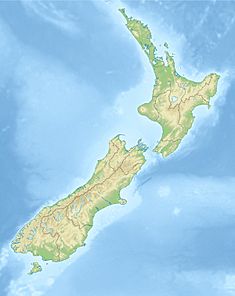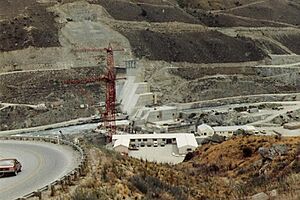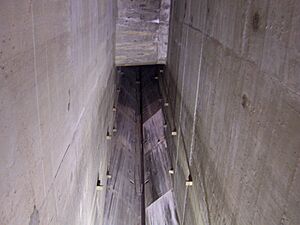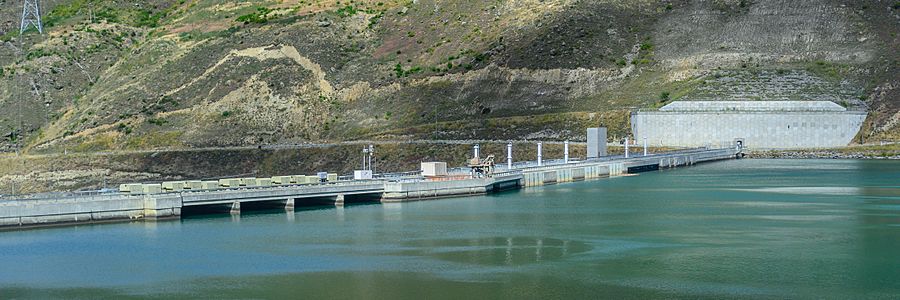Clyde Dam facts for kids
Quick facts for kids Clyde Dam |
|
|---|---|

Clyde Dam from the east, looking west
|
|
|
Location of Clyde Dam in New Zealand
|
|
| Location | Clyde, Otago, New Zealand |
| Coordinates | 45°10′46″S 169°18′25″E / 45.179314°S 169.306955°E |
| Dam and spillways | |
| Type of dam | Concrete gravity dam |
| Impounds | Clutha River |
| Height | 100 m (330 ft) |
| Length | 490 m (1,610 ft) |
| Width (crest) | 10 m (33 ft) |
| Width (base) | 70 m (230 ft) |
| Reservoir | |
| Creates | Lake Dunstan |
| Surface area | 26 km2 (10 sq mi) |
| Power station | |
| Operator(s) | Contact Energy |
| Commission date | 1992 |
| Turbines | 4× 108 MW (145,000 hp) Francis turbines |
| Installed capacity | 464 MW |
| Annual generation | 2,100 GWh |
The Clyde Dam is a huge structure built on the Clutha River in New Zealand. It's the third largest hydroelectric dam in the country. This means it uses the power of flowing water to create electricity. The dam is located near the town of Clyde and is managed by a company called Contact Energy.
Building the Clyde Dam
Building the Clyde Dam was a big project with many challenges. When it was first planned, there was a lot of discussion. Many people were worried because the dam would create a large lake. This lake would flood homes and fruit farms (orchards) in a nearby town called Cromwell. It would also cover the beautiful Cromwell Gorge, which was a popular spot for tourists.
To build the dam, a section of the main highway had to be moved. Also, a railway line that went past Clyde had to close down. Different governments had different ideas about how big the dam should be. Eventually, they decided to build a large dam.
There was also a debate about whether New Zealand really needed the dam. Some people thought it was necessary to power a new aluminium factory. After some legal challenges, a special law was passed in 1982 to allow the dam to be built.
The dam was built over many years, from 1982 to 1993. Once it was finished, they slowly filled it with water. This process started in 1992 and created a new lake called Lake Dunstan.
During construction, workers found a problem with the rock underneath the dam. It had tiny cracks because of an earthquake fault line. To make the dam safe, engineers had to redesign parts of it. They added a special "slip joint" that allows the dam to move a little if there's an earthquake. This joint can handle about 1 to 2 metres of ground movement. They also pumped a lot of cement into the rock to stop water from leaking.
All this extra work made the Clyde Dam the most expensive dam ever built in New Zealand. It also took longer to finish than planned. To help with landslides in the Cromwell Gorge, over 18 kilometres of tunnels were dug to drain water away.
How the Dam Works
The Clyde Dam has four large machines called Francis turbines. These turbines spin when water flows through them, creating electricity. Together, they can produce 464 megawatts (MW) of power. This is enough electricity for many homes and businesses. The dam was designed so that two more turbines could be added later, but there isn't enough water to keep them all running at full power.
In 2008, something unusual happened at the dam. Maintenance workers accidentally set off fire alarms. This caused a lot of carbon dioxide (CO2) gas to be released into the generator area. Firefighters had to check the dam to make sure the gas had cleared before it was safe.
Trivia
The Clyde Dam was still being built when it was used as a filming location. It appeared in the 1985 movie Shaker Run.
Gallery






